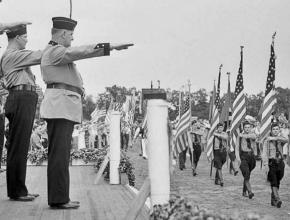Fascism’s American cousin
reviews a recently published pamphlet that provides important historical background to far-right organizing in the U.S. today.
ON A warm summer night last August, 250 mostly young white men dressed in uniforms of white polo shirts and khaki pants picked up torches and marched through the streets of Charlottesville, Virginia. As they marched, they chanted, "Jews will not replace us."
There was no mistaking who and what they were: Fascism was back on the streets of America.
Joe Allen's pamphlet When Fascism Was American chronicles a time when homegrown fascism came close to breaking out of its marginal existence and moving into the mainstream of U.S. politics. The lessons learned in fighting that threat in the tumultuous 1930s are essential reading for anyone interested in defeating these monsters from the id of capitalism.
On the day after President Paul von Hindenburg appointed Adolf Hitler chancellor of Germany, William Dudley Pelley founded the Silver Legion of America, or Silver Shirts. The Silver Shirts grew steadily in the middle 1930s, topping out at around 15,000 members.
As the decade wore on, however, recruitment slowed, and the Silver Shirts began to stagnate. Pelley chose Minneapolis as the place to reverse his organization's decline. He made a bad choice.

Minneapolis had a history of being a "bosses' town," a place where unions were not welcome and the business elite called the shots. That all changed in 1934, when the Teamsters of Local 544 organized and led a fightback that eventually turned into one of three general strikes that year, strikes that helped change the landscape of the American class struggle.
Through a long and bloody struggle, Local 544 and the workers of Minneapolis triumphed over the Citizen's Alliance--the bosses' vigilante group--and established the right to organize unions.
In 1938, Pelley and the Silver Shirts launched a recruitment drive in the Twin Cities, hoping to bring in 3,000-plus new members. When they came to town, Local 544 was ready for them. The Teamsters had 600 trained members in what was called the Union Defense Guard (UDG).
The UDG strived to be as independent from the union local as possible. Its goal was to reach out to as many workers as they could and bring them into a united front against the Silver Shirts. Allen details how this strategy was successful in out-mobilizing and confronting the fascists every time the Silver Shirts attempted to hold a public meeting.
THE GERMAN-American Bund was an even more formidable grouping than the Silver Shirts, reaching a height of 25,000 members. The Bund's leader, Fritz Kuhn, decided to roll the dice and turn his group into a household name.
Kuhn's plan was to hold a giant rally in New York's iconic Madison Square Garden. The date was set for February 20, 1939, just months after the horrific Kristallnacht. The message being sent was a clear and direct challenge to New York's large Jewish population.
While most of the official Jewish and left organizations, including the Communist Party, decided to ignore Kuhn's challenge, the relatively tiny Socialist Workers Party (SWP) mobilized to confront the fascists head-on.
The SWP printed and passed out over 200,000 flyers and brought out over 50,000 anti-fascists to surround the Garden. The ensuing street skirmishes and the large numbers were a clear defeat for the Bund, and marked the beginning of the end of their success.
The closest thing to a mass following for fascism in the U.S. came from the curious career of Father Charles Coughlin, the radio priest. By the early 1930s, Coughlin's radio show had 40 million listeners. Starting out as a New Deal supporter in 1932, Coughlin steadily moved to the right over the next several years.
In classic fascist form, Coughlin called for labor and management to unite in a "corporate state." What started out as a critique of bankers soon became a condemnation of "international finance," a code for Jewish bankers. The tentacles of Coughlin's Christian Front reached into the New York Police Department with over 400 cop members.
Allen covers a lot of ground in a small number of pages. A second edition would benefit from numbering those pages.


